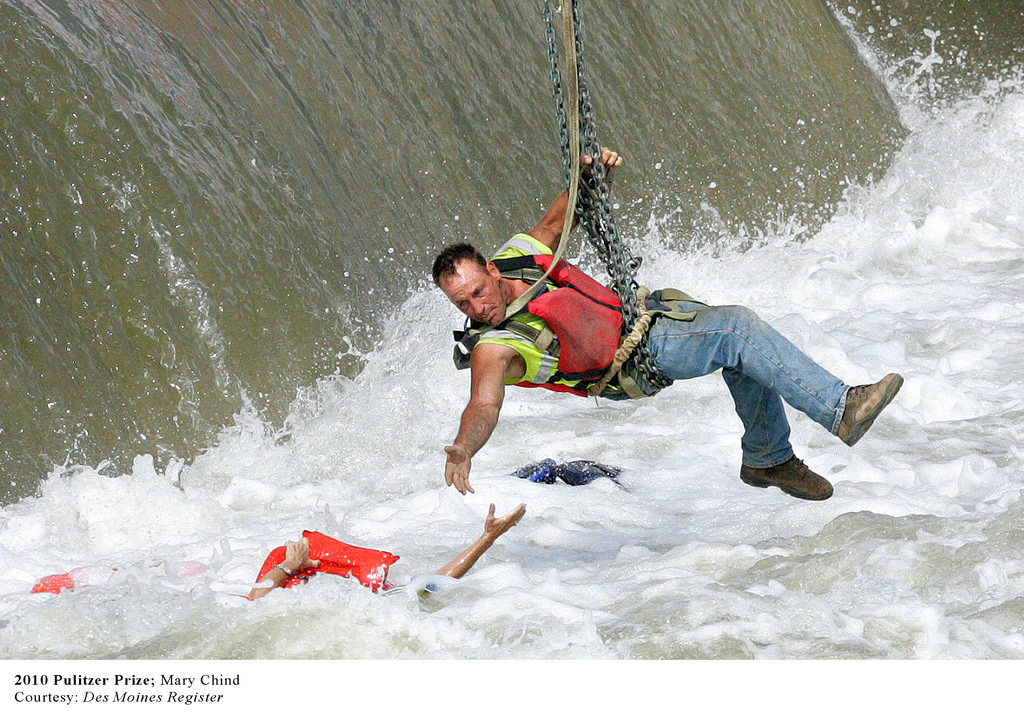
Four reasons why great photojournalism is art
By Eric Newton, senior adviser to the president at Knight Foundation Great photojournalism is a strange sort of art. Many of its creators do not see themselves as artists, but as truth-tellers who bristle at the notion that they could be creating salable art objects.
Yet what they do falls rather easily within the definition of art. The Oxford Dictionaries say art is the “expression or application of human creative skill and imagination.” Artworks come “typically in a visual form … to be appreciated primarily for their beauty or emotional power.”
That’s great photojournalism. See it for yourself at the exhibit that opens in Miami Feb. 12 at the Frost Museum of Art: “Capture the Moment: The Pulitzer Prize Photographs.” Nearly 3 million people have viewed this exhibit in 34 venues in the United States and Asia during the past dozen years. Most of those millions saw the show in art museums.
The critics would object. “Art may be hard to define,” wrote Anthony Tommasini of the New York Times, “but whatever art is, it’s a step removed from reality. A theatrical depiction of suffering may be art; real suffering is not. … The image of a naked, fleeing, napalm-burned Vietnamese girl is truth, not art. Images of the blazing twin towers, however horrifically compelling, are not art.”
I disagree. Here are four reasons why photojournalism absolutely is art:
- Realism is art. For centuries sculptors and painters have depicted pain. “About suffering they were never wrong,” wrote poet W.H. Auden. “The Old Masters; how well, they understood/ Its human position; how it takes place…” In the early days of photojournalism, New York crowds thronged to galleries to see Civil War images taken by Mathew Brady and Alexander Gardner. Newspapers of the day lacked the technology to print photos, so Americans lost the romantic image they had of war in exhibit halls. The New York Times wrote then of “hushed reverent groups” gathered “… to look in the pale faces of the dead, chained by the strange spell that dwells in dead men’s eyes.”
- Photojournalism is creative. Carol Guzy, four-time Pulitzer-winner (with the Washington Post and the Miami Herald), says good pictures come from the ability to “open your mind a little bit and see differently… ” News photographers produce their art within the space of a fraction of a second, the fleeting instant in which photographer, camera, image and subject all fall into place, a moment that is either frozen indelibly or forever lost. So it’s not just art; it’s difficult art to create, often done so under the most dangerous of circumstances.
- Photojournalism withstands the test of time. One of the photos in the Pulitzer exhibit is Joe Rosenthal’s image of Marines raising a flag at Iwo Jima, an American icon for 70 years. The picture was transformed into the U.S. Marine Corps War Memorial. No one would debate that the sculpture is art. Why debate its photographic progenitor? Art elevates the ordinary. A moment on a battlefield becomes a memorial.
- Photojournalism moves us. A good photograph, Vietnam War photographer Eddie Adams used to say, “reaches into your chest and tears your heart out.” What it does with your heart after that depends upon the picture. You might cry to music, marvel at dance or puzzle over a painting. Or you might feel all of that at a photojournalism exhibit. News photographs speak in a universal language that ignores national and cultural borders. They carry big ideas into our souls.
Photojournalism is realism in its freshest form, direct from nature; it’s creative; it stands the test of time; it moves us and inspires us to see things differently. What more can we ask of art?
Granted, not all photojournalism is great art, just as not all writing is great literature and not all music is memorable. But sometimes it is art, even when photojournalists themselves, who want their work distributed to the widest community possible, object to the more covetous conventions of the art world. I would certainly agree that some tragedies should never become a “limited edition set.”
Art tolerates any number of sub-genres. Yet the debate may never end over whether news photos are too real to be art. Still, I hope one day our esteemed critics and academics will realize there is a reason some of these pictures simply will not go away. Trying to understand that reason will lead them to an exciting adventure into the art of photojournalism.
Eric Newton is senior adviser to the president at Knight Foundation, co-sponsor of the Frost Museum exhibit. Newton led the Oakland Tribune coverage of the 1989 Loma Prieta earthquake, for which the Tribune photo staff won a Pulitzer Prize. He is co-editor with exhibit creator Cyma Rubin of the book “The Pulitzer Prize Photographs: Capture the Moment.” Related link: “Photojournalism, a slice of time, constrainted from being art” by Hunter Braithwaite on KnightBlog.org.